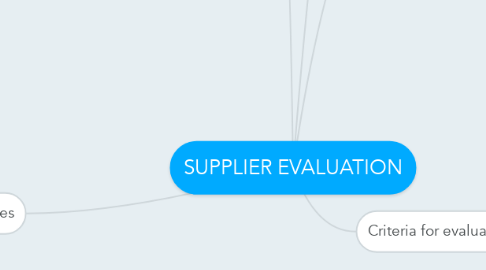
1. Evaluation methods/approaches
1.1. Mathematics
1.1.1. Analytic hierarchy process (AHP) Evaluation based on hierarchical model.
1.1.2. Linear programming (LP) Measures intangible and tangible factors.
1.1.3. Multi-objective Programming A tool for negotiate and evaluate vendors and potential suppliers.
1.1.4. Goal Programming (GP) Measures qualitative and quantitative data.
1.2. Statistics
1.2.1. Cluster analysis Groups similar objectives into categories. (http://www.statsoft.com/Textbook/Cluster-Analysis)
1.2.2. Multiple regression A tool for learning about relationships between variables. (http://www.statsoft.com/textbook/multiple-regression)
1.2.3. Principal component analysis "A technique used to emphasize variation and bring out strong patterns in a dataset." (http://setosa.io/ev/principal-component-analysis/)
1.3. Artificial Intelligence
1.3.1. Software agent "A software agent is an piece of software that functions as an agent for a user or another program, working autonomously and continuously in a particular environment." (http://www.techopedia.com/definition/24595/software-agent)
1.3.2. Fuzzy Set Theory (FST) Good method for small suppliers. Used for engineering and machinery sectors.
1.4. (http://www.google.fi/url?sa=t&rct=j&q=&esrc=s&source=web&cd=12&ved=0CGkQFjAL&url=http%3A%2F%2Fbrd4.ort.org.il%2F~bashkansky%2Fatqe%2Flectures%2FAHP%2FAHP-Saaty%2FSupplierEvaluation-Selection.ppt&ei=1k8-VbTdIomdsgGvjoDgDg&usg=AFQjCNGqKakCt136FEkuOVykcIBh6Ah7IQ&sig2=sbQPwChe-3z_OtejJmRDvQ)
1.5. Surveys and questionnaires
1.6. Scorecards Most common and widely used because they can show various data at a glance. (Teacher's lecture notes)
2. = Evaluation of existing or new suppliers based on their delivery, prices, production capacity, quality of management, technical capabilities, and service. (http://www.businessdictionary.com/definition/supplier-evaluation.html)
3. Goals of supplier evaluation
3.1. Make available a basis for evaluation of potential and existing suppliers. Provide an overall procedure for all companies to allow full use of the results within the parent organization. Provide a supplier data set within various areas (components, functional and technological). Give more information about each supplier. Act as a tool for developing suppliers and the supplier structure. Assist in decision making which is based on facts. Give various data for running supplier reward programme. Share information about suppliers to various other disciplines. (http://hosteddocs.ittoolbox.com/SS100104.pdf)
4. Evaluation strategy
4.1. Helps to decide which suppliers are to be measured and what level of evaluation is applied to different supplier segments. (Teacher's lecture notes)
4.2. Defines 2 main things: 1. How suppliers are segmented? 2. What is the way to evaluate suppliers in each segment? (Teacher's lecture notes)
4.2.1. Example of evaluation strategy: (Check the online text box from Moodle)
4.3. Constructed from hi-level monitoring to detailed evaluation.
4.4. Supply base segmentation
4.4.1. Categorizes suppliers using different variables and aspects. This is done to monitor suppliers. (Teacher's lecture notes)
4.4.1.1. 4 steps for segmenting suppliers:
4.4.1.1.1. 1. identify the most important types of supplier relationships based on the company's strategies
4.4.1.1.2. 2. Review the company's supplier performance expectations. Identify the suppliers who help the company achieve its objectives and goals.
4.4.1.1.3. 3. Review important categories of supplier. They can be high-priority or strategically important. After this the suppliers can be segmented based on their strategic value.
4.4.1.1.4. 4. Identify top-sped and low-spend suppliers. To help with this, track the suppliers' performances more closely.
4.4.1.1.5. (http://valuechaingroup.com/four-steps-to-segmenting-your-supply-base-for-performance-management/#sthash.JB4zj35e.dpbs)
